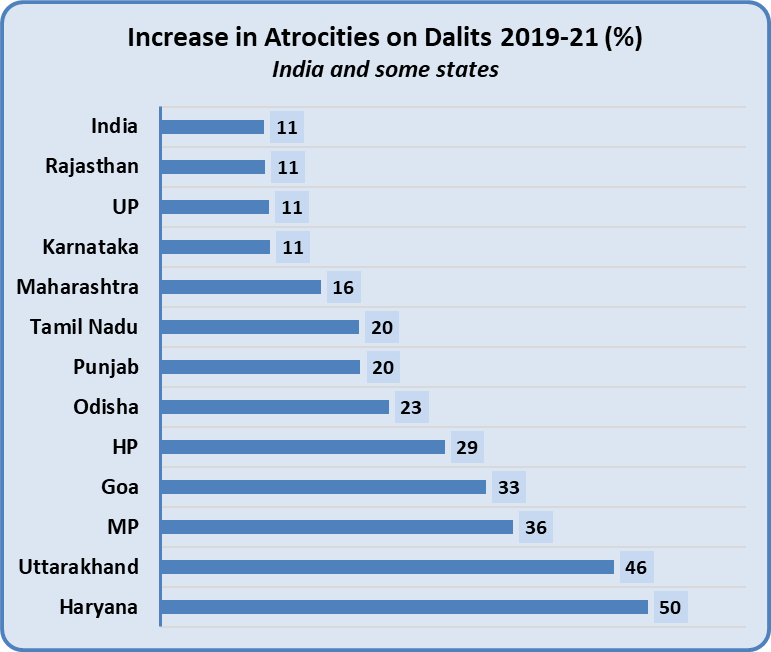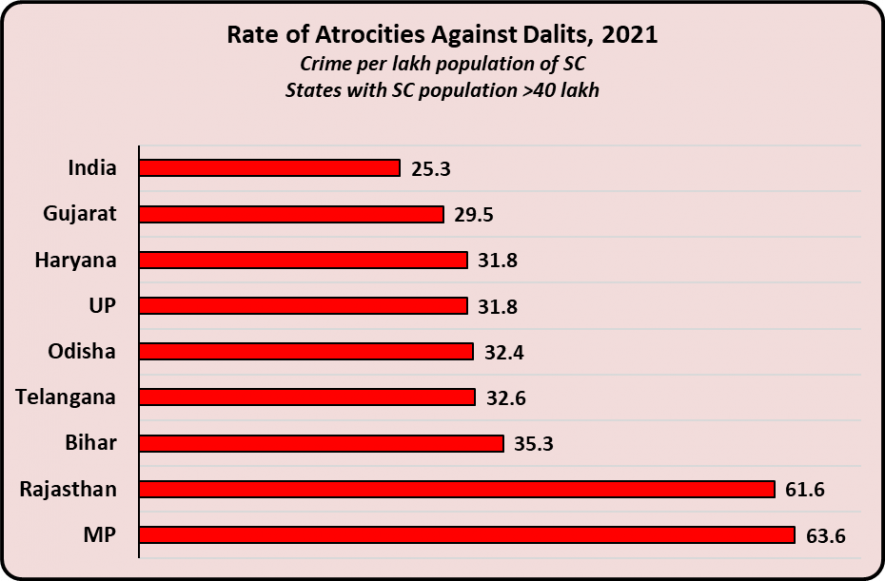In most BJP-ruled states, such violence is ominously rising, but the same is also true for some states ruled by Opposition parties.
Representational use only.Image Courtesy: Huffpost.Com
On the eve of the 75th Anniversary of Independence in August, a nine-year-old Dalit boy died from injuries suffered weeks earlier. The boy, a student of class 3 in Jalore district of Rajasthan, was severely beaten by his teacher for allegedly touching a water pot. In September, a 15-year-old boy in UP’s Auriya district similarly died after his teacher beat him up for making a mistake in his test. A few days later, two Dalit sisters from a village in Lakhimpur Kheri of UP were raped and murdered, their bodies left hanging from a tree. This series of atrocities hit the media headlines, shocking the country and beyond. Culprits were arrested, compensation announced and outrage registered duly by one and all.
But such incidents are a fraction of the violence and oppression that Dalits continue to suffer in India, which is claimed to be entering the Amrit Kaal – starting from the 75th Anniversary of Independence and going up to the centenary in 2047. Since 1991, from when the data is available, over 7 lakh atrocities have been officially recorded by the police. That is about five every hour. And these are just the officially registered cases. A large number of cases routinely go unregistered because of the connections of higher caste culprits and survivors being in fear of the perpetrators.
Some States Showing Increasing Violence
In the last three years, from 2019 to 2021, the country saw an 11% increase in atrocities against Dalits. Recorded cases rose from 45,961 in 2019 to 50,900 in 2021, according to the latest available data from the National Crime Records Bureau (NCRB).
The increase is driven by enormous spikes in this violence (and their registration) in a clutch of states. The chart below shows the data for states with a higher percentage increase in anti-dalit atrocities than the national average.

As can be seen, the entire northern Indian belt – barring Bihar – has shown a spike in atrocities that is higher than the national average. In Bihar (not shown in the chart), as also in neighbouring Chhattisgarh and Jharkhand, the number of registered atrocities declined.
It is noticeable that almost all Bharatiya Janata Party-ruled states are exhibiting a larger-than-average increase, the exception being Gujarat. Such states include Madhya Pradesh, Haryana, Uttarakhand, Goa, Himachal Pradesh, Karnataka, and Uttar Pradesh. But several Opposition-governed states like Tamil Nadu, Rajasthan, and Maharashtra (led by an Opposition alliance in the period covered) also figure in this list.
While the upper caste-oriented ideology of the Sangh Parivar, including the BJP, can be presumed to contribute to this worrisome situation, it needs to be stressed that caste oppression is systemic and weaved in the fabric of Indian society. It may get aggravated because of government negligence or even connivance, but the state machinery itself is significantly influenced by upper caste biases. On the other hand, Dalit communities are primarily poor, landless, labouring sections, which have been stigmatised and marginalised for centuries, without the wherewithal to resist oppression. Even political empowerment – like having elected representatives – has not done much to restrain the stranglehold of caste oppression.
Violence in Relation to Dalit Population
A different dimension of the issue is revealed if one looks at the crime rate, that is, the number of crimes per 1 lakh population of Scheduled Castes (Dalits) in a particular state. This measure is meaningful because the Dalit population varies widely across states; hence comparing the number of atrocities is often misleading. States with a higher Dalit population may have a higher number of cases, which makes its comparison with a state with a small Dalit population untenable.
The chart below shows the crime rate for atrocities against Dalits in states with over 40 lakh Dalit population and higher than the country-wide average crime rate of about 25 cases of atrocities per lakh of Dalit population.

As can be seen, Madhya Pradesh and Rajasthan are again the two states with the highest crime rates, almost two and a half times the national average. Other states in this list include Bihar, Telangana, Odisha, Uttar Pradesh and Haryana (all above 30), and Gujarat (just below 30, at 29.5). Notable states with a relatively high Dalit population but not so high rates of crimes against Dalits include West Bengal, Tamil Nadu, Punjab, Maharashtra, and Karnataka.
Strikingly, the northern belt of states is again featured in this – showing that they are the states with noticeably higher rates of crimes against Dalits.
What are Dominant Political Parties Doing?
It is strange that the oppression of Dalits continues unabated and across the board despite all the talk of Dalit empowerment by dominant parties like the BJP and Congress, as also state-level strong parties like the Samajwadi Party or the Biju Janata Dal, or even the Bahujan Samaj Party that claims to represent the interests of the Dalit population.
While strengthening laws, and their diligent and unbiased implementation through the police and courts are necessary steps to be taken at the administrative levels, the situation calls for a much more extensive change in the social and economic realms. Only through such measures – like land to the Dalit landless, jobs, education, housing, and medical care – can the material basis for their empowerment be laid. This, of course, needs to be accompanied by a sweeping social campaign to break the practice of discrimination and violence.
The dominant political parties, and their multiple affiliates, especially the RSS-BJP cohort, need to be asked why they have not undertaken such a course until now, despite claiming to be electoral and socio-cultural leaders of a large population segment.
Courtesy: Newsclick
